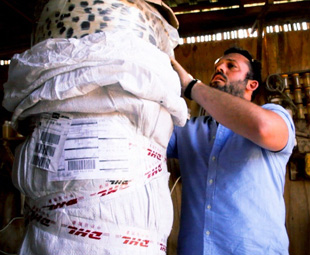Making a real difference with fake fur

Africa really is a wonderful place in which to live … with its breathtaking scenery, wonderful outdoor living and magnificent wildlife, which can all be enjoyed throughout the continent’s national parks. But, heartbreakingly, the majestic wild creatures are hunted for their horns, hides and numerous other body parts.
Enter the agreement between DHL and Panthera (a global big-cat conservation organisation based in the United States) – which will ensure the preservation of both cultural and natural heritage. This partnership will see DHL ship faux leopard skins, on behalf of Panthera, from manufacturers in China to South Africa on a pro bono basis. The agreement aims to help protect the endangered species, the skins of which are ceremonially worn by followers of the Shembe community in South Africa.
Hennie Heymans, managing director of DHL Express South Africa, says: “Conservation is a major issue in Africa and there is a lot of passion for the ‘big five’ animals: namely elephant, rhinoceros, lion, Cape buffalo and leopard – with elephants and rhinos in particular getting a lot of attention. However, there are many endangered species in the region, such as the leopards, that receive little publicity or support.”
 As a result DHL is providing its logistics expertise and raising awareness of a complex issue through its own network and resources. “This partnership between Panthera and DHL is a natural fit, as Panthera’s big cat expertise combined with DHL’s global reach is a winning solution for conservation,” adds Heymans.
As a result DHL is providing its logistics expertise and raising awareness of a complex issue through its own network and resources. “This partnership between Panthera and DHL is a natural fit, as Panthera’s big cat expertise combined with DHL’s global reach is a winning solution for conservation,” adds Heymans.
The Shembe community will also benefit as the costs associated with international shipping and distribution will be defrayed by DHL’s complimentary logistics support. Shembe elder and legal advisor, Lizwi Ncwane, states: “As a leader of the Shembe community I have seen how receptive my community is to using these fake skins. Not only do they look and feel like real leopard skins, they also last longer. We’re grateful that Panthera has worked with us in finding a solution that interweaves the conservation of leopards with the customs of the Shembe.”
Leopard skins have become customary ceremonial attire worn by the over five-million members of the Shembe church, which has been a part of the vibrant cultural landscape of South Africa for over 100 years. Previously worn by Zulu royalty and chiefs, the leopard skins (or “amambatha” – as they are referred to locally) form part of a ceremonial and religious dress that symbolises beauty, power and prestige.
These amambatha are now desired by a growing number of male Shembe followers. At a single Shembe gathering, over 1 000 leopard skins are worn by members. Although many skins are passed down from generation to generation, some new ones (resulting from poaching) are leading to shrinking leopard numbers.
Luke Hunter, president of Panthera, states: “To date 2 000 faux leopard amambatha, or traditional shoulder capes, have been shipped by DHL for our project. The Shembe have shown that they are willing to embrace the use of our high-quality alternative to real leopard skins – which translates to 1 000 leopards being saved from poachers. We could only have made such major strides in conserving the magnificent leopard with the cooperation of the Shembe and the support of DHL.”
Click here for more on the DHL-Panthera collaboration.
Published by
Focus on Transport
focusmagsa




